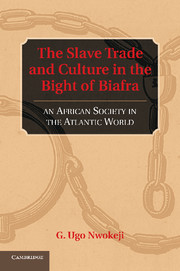Book contents
- Frontmatter
- Contents
- List of Tables and Figures
- Map of the Bight of Biafra and Its Hinterland
- Preface
- Foreword by Paul E. Lovejoy
- 1 Introduction
- 2 The Aro in the Atlantic Context: Expansion and Shifts, 1600s–1807
- 3 The Trade Diaspora in Regional Context: Aro Commercial Organization in the Era of Expansion, 1740–1850
- 4 Culture Formation in the Trading Frontier, c. 1740 to c. 1850
- 5 Household and Market Persons: Deportees and Society, c. 1740–c. 1850
- 6 The Slave Trade, Gender, and Culture
- 7 Cultural and Economic Aftershocks
- 8 Summary and Conclusions
- Notes on Sources
- Sources Cited
- Index
6 - The Slave Trade, Gender, and Culture
Published online by Cambridge University Press: 06 December 2010
- Frontmatter
- Contents
- List of Tables and Figures
- Map of the Bight of Biafra and Its Hinterland
- Preface
- Foreword by Paul E. Lovejoy
- 1 Introduction
- 2 The Aro in the Atlantic Context: Expansion and Shifts, 1600s–1807
- 3 The Trade Diaspora in Regional Context: Aro Commercial Organization in the Era of Expansion, 1740–1850
- 4 Culture Formation in the Trading Frontier, c. 1740 to c. 1850
- 5 Household and Market Persons: Deportees and Society, c. 1740–c. 1850
- 6 The Slave Trade, Gender, and Culture
- 7 Cultural and Economic Aftershocks
- 8 Summary and Conclusions
- Notes on Sources
- Sources Cited
- Index
Summary
Whether a captive ended up in the Americas or was retained in the region was not only a function of his or her origin, skills, or means of enslavement but also of indigenous conceptions of gender. This chapter shows that constructions of gender roles helped to shape the age and sex structure of the Atlantic slave trade. Understanding the gender structure of the transatlantic slave trade is critical to understanding the societies of the Bight of Biafra and the rest of the Atlantic world. Considering the issue from the broad perspective of contact between the Old World and the New, two salient characteristics of that structure have emerged in the literature. First, as is now well known, males predominated in the Atlantic slave trade, though compared to other branches of pre-nineteenth-century migration, both coerced and free, females and children were well represented. Second, the proportion of African women and children carried across the Atlantic was far from constant or uniform; sex and age ratios varied strongly by region and over time (Eltis and Engerman 1993:308; Eltis and Richardson 1995a). Attempts to explain these broad patterns have generally focused on the economic functions of slaves on both sides of the Atlantic, and especially, on the requirements of the plantation complexes of the Americas, without which a transatlantic slave trade would not have existed. Even though New World planters demanded men, they quickly discovered that enslaved African women had a high work rate.
- Type
- Chapter
- Information
- The Slave Trade and Culture in the Bight of BiafraAn African Society in the Atlantic World, pp. 144 - 177Publisher: Cambridge University PressPrint publication year: 2010

